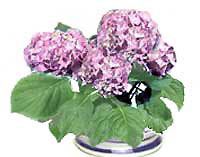Hydrangea (hydrangea) / (hydrangea)
It belongs to the family saxifrage. Fatherland is Japan and China.
General description: The only species grown in room conditions
Hydrangea macrophylla (Hydrangea large leaf). Leaves ovate with a serrate margin, 10-15 cm in length. Inflorescence globose or corymbose, with large marginal flowers (up to 20 cm in diameter). Usually on one bush blossom 3-6 flower caps. Blooms from spring until autumn. The color of the inflorescences is different depending on the variety - snow-white, lilac, pink, red, purple.
After flowering it is necessary to prune.
Recommendations for the care of plants Hortensia:
Illumination : Needs bright, but diffused light. In the period of inactivity they are kept in the dark.
Irrigation regime : During the growth period, it needs abundant watering with warm water according to the drying out of the earth. In the winter, irrigation is very outlandish.
Humidity : In summer, hydrangeas need regular spraying.
In winter, the dry essence.
Temperature regime : Need coolness. For the summer it is better to place on a fresh atmosphere (in a park or on a balcony), preferably to dig pots in the ground. In winter, the optimum is 6-8 C °. By spring, you need to gradually accustom to higher temperatures.
Soil: A slightly acidic reaction is preferred (pH = 5.5). At pH = 4.5, the flowers become blue.
Recommended soil mix: 1 share of coniferous soil, 1 share of peat, 1/2 elements of humus and 1/2 elements of sand.
During the flowering period, it needs periodic fertilizing with liquid complex fertilizers for flowering plants. In summer and in the end of winter it is useful to make organic.
Breeding : Root cuttings from radical shoots with duplicated-three pairs of leaves, without buds. Rooting is first produced in sand, then in a mixture of peat, leaf earth and sand. Unfortunately, in room conditions it is seldom successful.
Transplant : Annually after flowering .
Pests : It is affected by scarlet spider mites (in a dry atmosphere, leaves and stems are braided with cobwebs).
Sometimes aphids can be affected, especially in summer, in the fresh air. Damaged leaves and tops of shoots become discolored and dry up.
It is necessary to spray with pesticides (inta-vir, derris, actellicum, phytophythm, etc.)
It is not bad to use folk remedies: tobacco solutions, onion infusions, garlic-soap solutions.

Hydrangea (Hydrangea) - (Hydrangea)


Comments
Commenting on, remember that the content and tone of your message can hurt the feelings of real people, show respect and tolerance to your interlocutors even if you do not share their opinion, your behavior in the conditions of freedom of expression and anonymity provided by the Internet, changes Not only virtual, but also the real world. All comments are hidden from the index, spam is controlled.